MAR013 Intercultural Competence: Case Study on Cross-Cultural Issues
VerifiedAdded on 2023/01/09
|9
|2089
|40
Case Study
AI Summary
This case study analyzes a scenario involving intercultural communication challenges faced by a corporate attorney, Hannah Muller, during business negotiations in Japan. The assignment explores the issues arising from cross-cultural differences, including communication styles, business practices, and cultural frameworks. The solution identifies the mistakes made by Hannah and the company, such as the lack of a negotiator and inadequate understanding of Japanese business etiquette. It proposes solutions like improving communication, learning about diverse cultures, and utilizing intercultural theories like Hall's cultural factors and the Onion model. The analysis recommends strategies for Hannah and the company to improve intercultural competence, including appointing negotiators, enhancing cultural knowledge, and fostering diversity within the company. The document highlights the importance of understanding cultural nuances to ensure successful business deals and effective cross-cultural interactions. The case study emphasizes the application of relevant theories and frameworks to address intercultural business challenges, demonstrating the student's understanding of the subject.
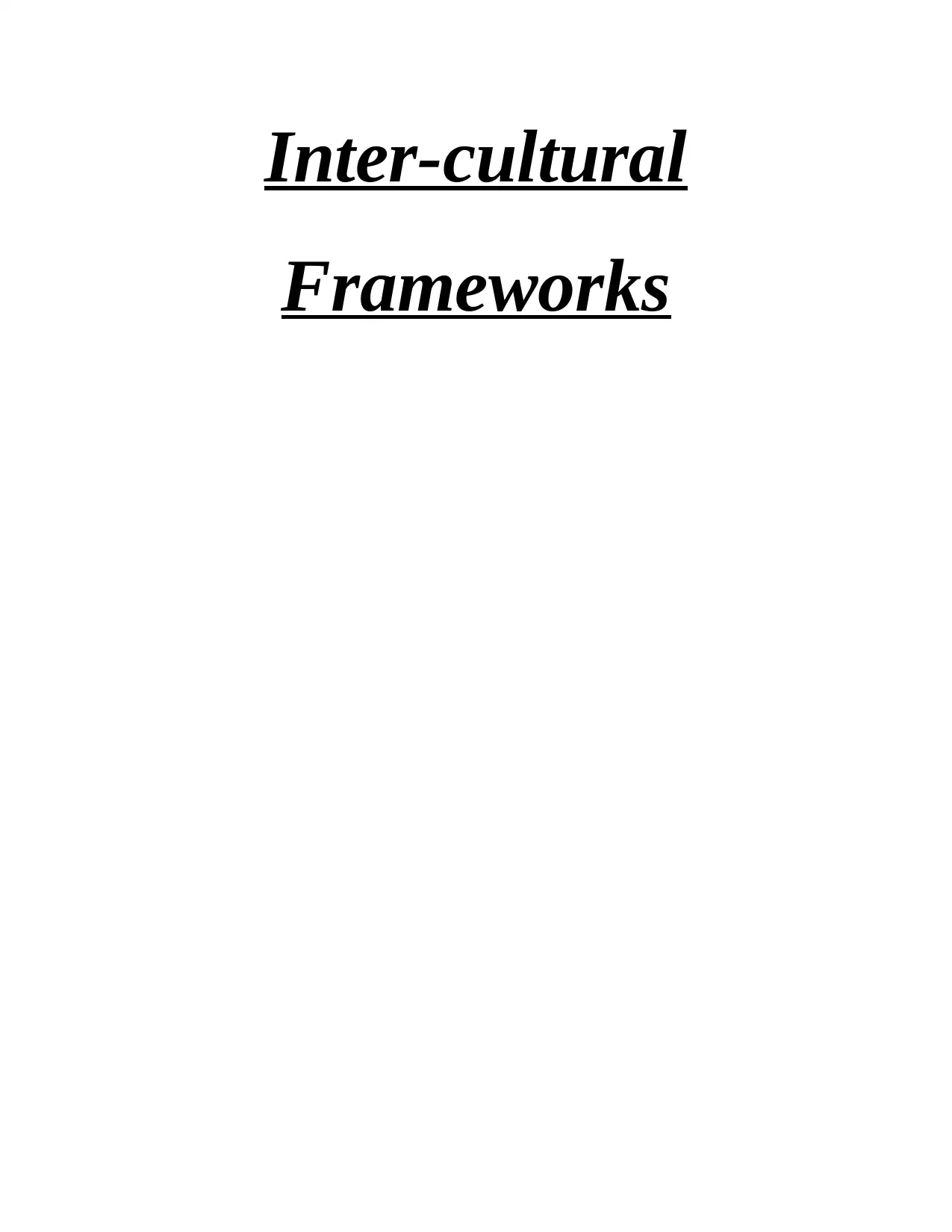
Inter-cultural
Frameworks
Frameworks
Paraphrase This Document
Need a fresh take? Get an instant paraphrase of this document with our AI Paraphraser
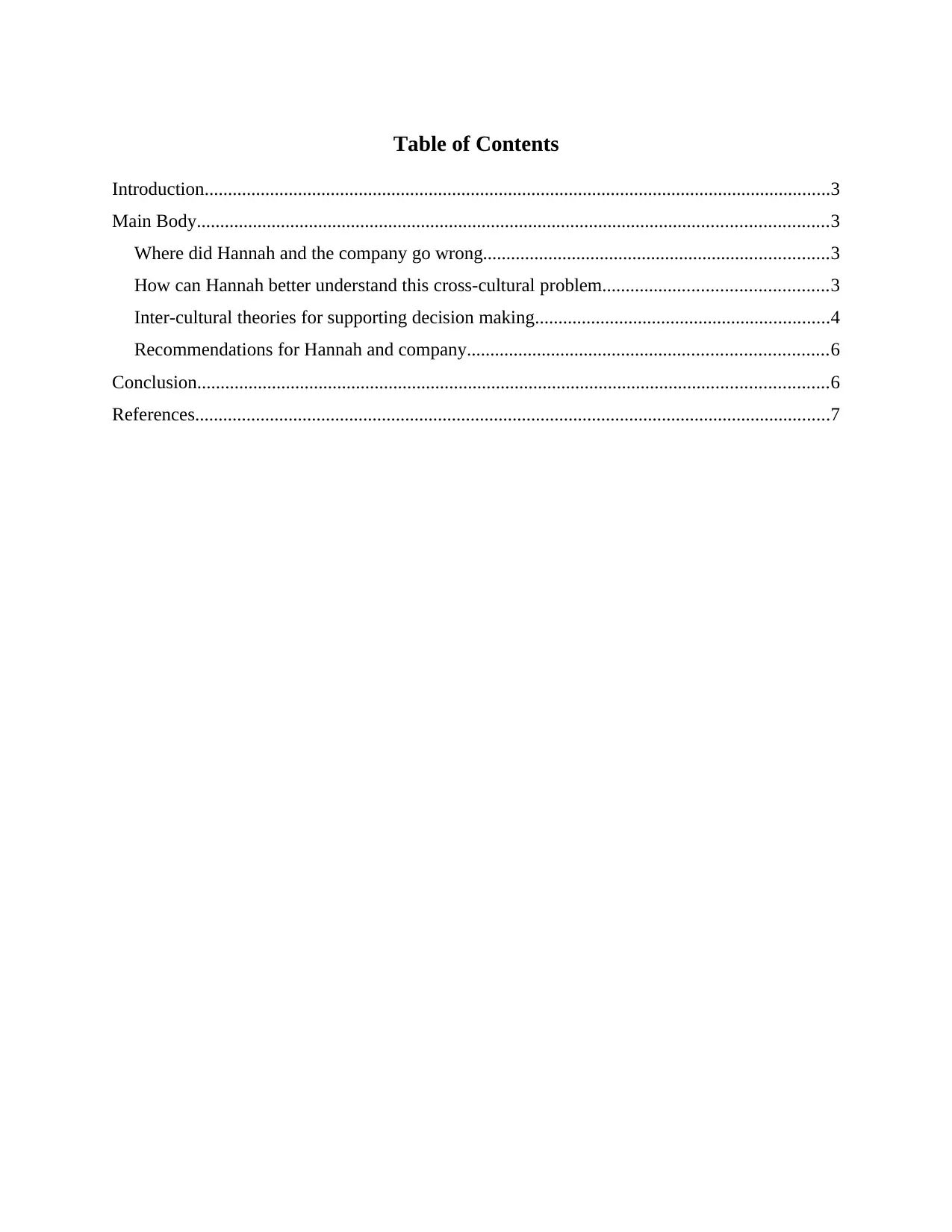
Table of Contents
Introduction......................................................................................................................................3
Main Body.......................................................................................................................................3
Where did Hannah and the company go wrong..........................................................................3
How can Hannah better understand this cross-cultural problem................................................3
Inter-cultural theories for supporting decision making...............................................................4
Recommendations for Hannah and company.............................................................................6
Conclusion.......................................................................................................................................6
References........................................................................................................................................7
Introduction......................................................................................................................................3
Main Body.......................................................................................................................................3
Where did Hannah and the company go wrong..........................................................................3
How can Hannah better understand this cross-cultural problem................................................3
Inter-cultural theories for supporting decision making...............................................................4
Recommendations for Hannah and company.............................................................................6
Conclusion.......................................................................................................................................6
References........................................................................................................................................7
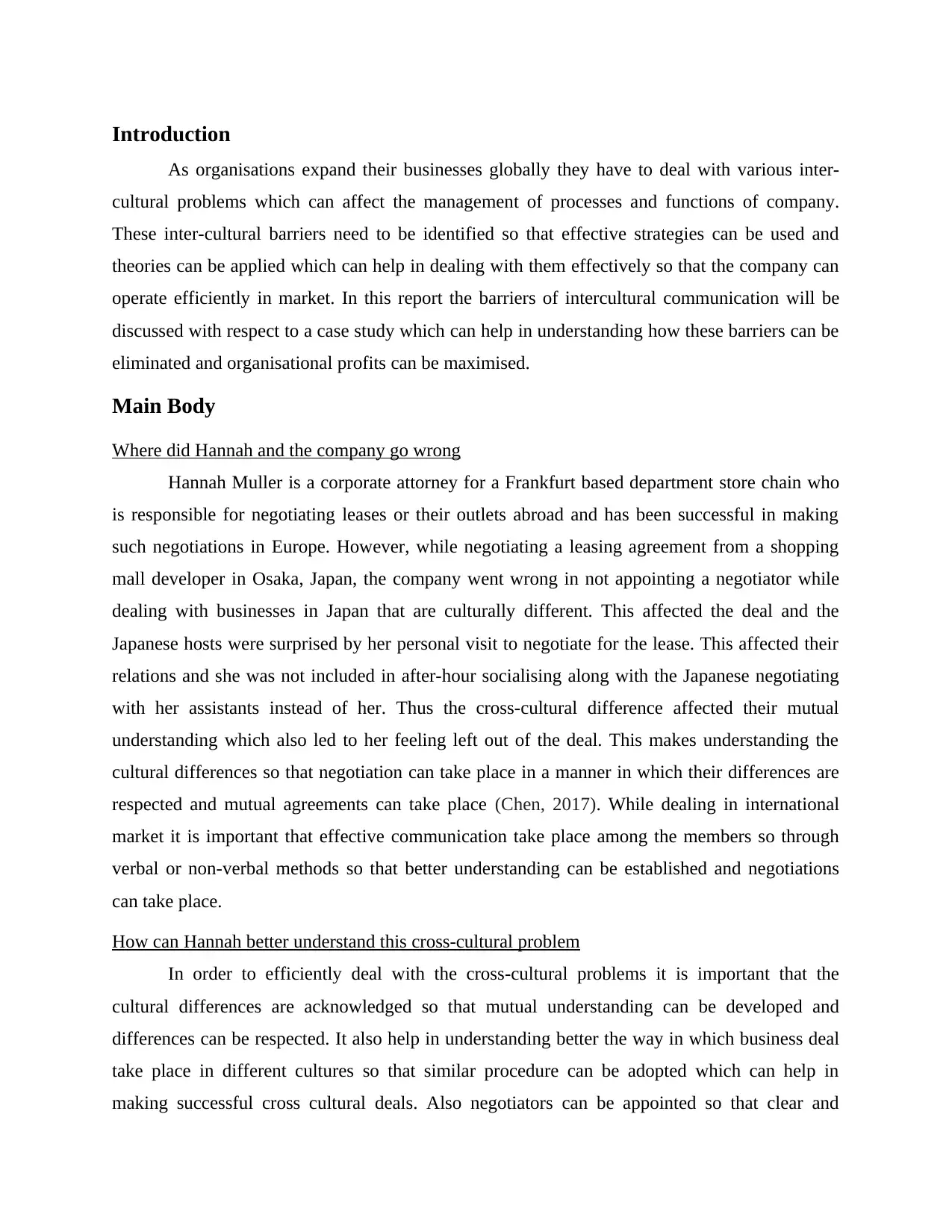
Introduction
As organisations expand their businesses globally they have to deal with various inter-
cultural problems which can affect the management of processes and functions of company.
These inter-cultural barriers need to be identified so that effective strategies can be used and
theories can be applied which can help in dealing with them effectively so that the company can
operate efficiently in market. In this report the barriers of intercultural communication will be
discussed with respect to a case study which can help in understanding how these barriers can be
eliminated and organisational profits can be maximised.
Main Body
Where did Hannah and the company go wrong
Hannah Muller is a corporate attorney for a Frankfurt based department store chain who
is responsible for negotiating leases or their outlets abroad and has been successful in making
such negotiations in Europe. However, while negotiating a leasing agreement from a shopping
mall developer in Osaka, Japan, the company went wrong in not appointing a negotiator while
dealing with businesses in Japan that are culturally different. This affected the deal and the
Japanese hosts were surprised by her personal visit to negotiate for the lease. This affected their
relations and she was not included in after-hour socialising along with the Japanese negotiating
with her assistants instead of her. Thus the cross-cultural difference affected their mutual
understanding which also led to her feeling left out of the deal. This makes understanding the
cultural differences so that negotiation can take place in a manner in which their differences are
respected and mutual agreements can take place (Chen, 2017). While dealing in international
market it is important that effective communication take place among the members so through
verbal or non-verbal methods so that better understanding can be established and negotiations
can take place.
How can Hannah better understand this cross-cultural problem
In order to efficiently deal with the cross-cultural problems it is important that the
cultural differences are acknowledged so that mutual understanding can be developed and
differences can be respected. It also help in understanding better the way in which business deal
take place in different cultures so that similar procedure can be adopted which can help in
making successful cross cultural deals. Also negotiators can be appointed so that clear and
As organisations expand their businesses globally they have to deal with various inter-
cultural problems which can affect the management of processes and functions of company.
These inter-cultural barriers need to be identified so that effective strategies can be used and
theories can be applied which can help in dealing with them effectively so that the company can
operate efficiently in market. In this report the barriers of intercultural communication will be
discussed with respect to a case study which can help in understanding how these barriers can be
eliminated and organisational profits can be maximised.
Main Body
Where did Hannah and the company go wrong
Hannah Muller is a corporate attorney for a Frankfurt based department store chain who
is responsible for negotiating leases or their outlets abroad and has been successful in making
such negotiations in Europe. However, while negotiating a leasing agreement from a shopping
mall developer in Osaka, Japan, the company went wrong in not appointing a negotiator while
dealing with businesses in Japan that are culturally different. This affected the deal and the
Japanese hosts were surprised by her personal visit to negotiate for the lease. This affected their
relations and she was not included in after-hour socialising along with the Japanese negotiating
with her assistants instead of her. Thus the cross-cultural difference affected their mutual
understanding which also led to her feeling left out of the deal. This makes understanding the
cultural differences so that negotiation can take place in a manner in which their differences are
respected and mutual agreements can take place (Chen, 2017). While dealing in international
market it is important that effective communication take place among the members so through
verbal or non-verbal methods so that better understanding can be established and negotiations
can take place.
How can Hannah better understand this cross-cultural problem
In order to efficiently deal with the cross-cultural problems it is important that the
cultural differences are acknowledged so that mutual understanding can be developed and
differences can be respected. It also help in understanding better the way in which business deal
take place in different cultures so that similar procedure can be adopted which can help in
making successful cross cultural deals. Also negotiators can be appointed so that clear and
⊘ This is a preview!⊘
Do you want full access?
Subscribe today to unlock all pages.

Trusted by 1+ million students worldwide
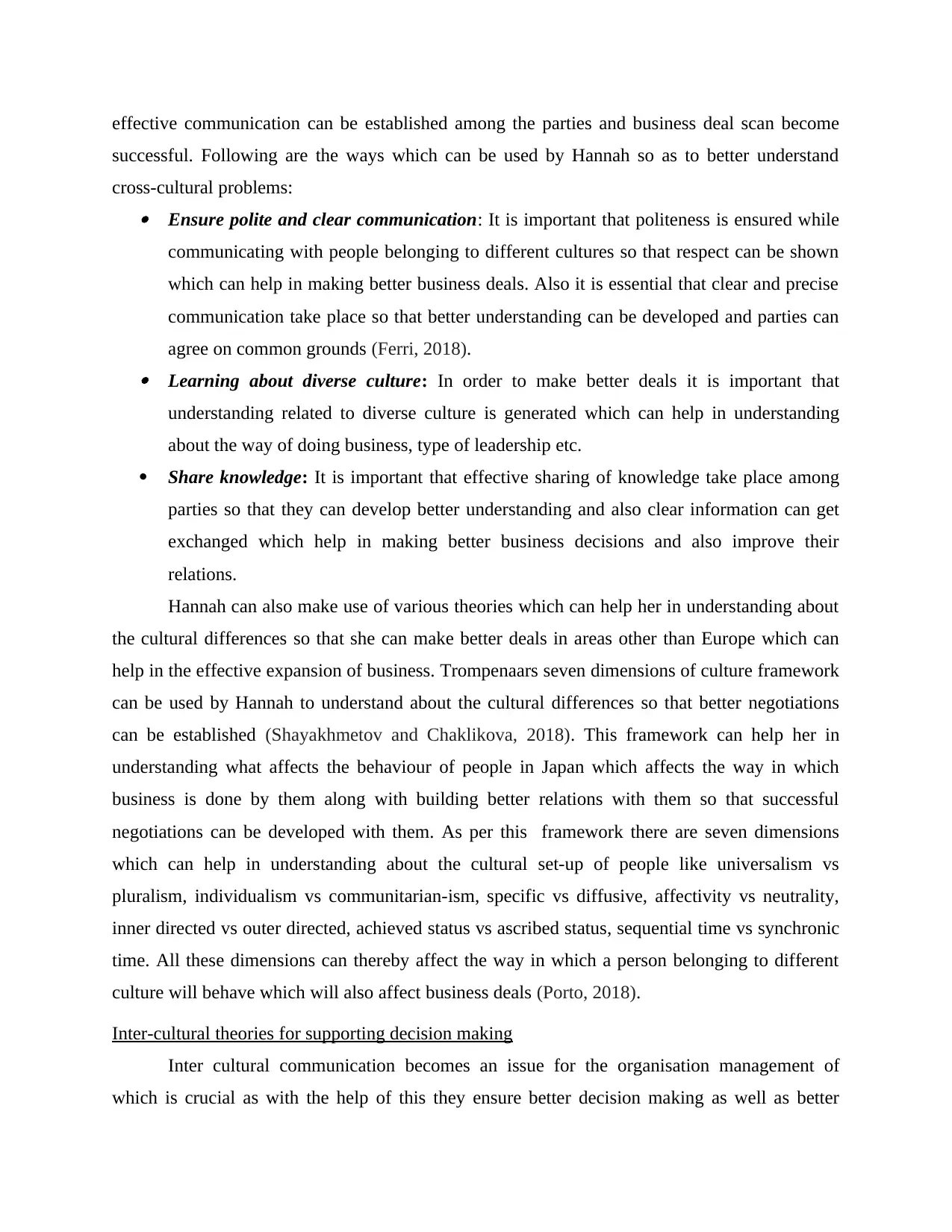
effective communication can be established among the parties and business deal scan become
successful. Following are the ways which can be used by Hannah so as to better understand
cross-cultural problems: Ensure polite and clear communication: It is important that politeness is ensured while
communicating with people belonging to different cultures so that respect can be shown
which can help in making better business deals. Also it is essential that clear and precise
communication take place so that better understanding can be developed and parties can
agree on common grounds (Ferri, 2018). Learning about diverse culture: In order to make better deals it is important that
understanding related to diverse culture is generated which can help in understanding
about the way of doing business, type of leadership etc.
Share knowledge: It is important that effective sharing of knowledge take place among
parties so that they can develop better understanding and also clear information can get
exchanged which help in making better business decisions and also improve their
relations.
Hannah can also make use of various theories which can help her in understanding about
the cultural differences so that she can make better deals in areas other than Europe which can
help in the effective expansion of business. Trompenaars seven dimensions of culture framework
can be used by Hannah to understand about the cultural differences so that better negotiations
can be established (Shayakhmetov and Chaklikova, 2018). This framework can help her in
understanding what affects the behaviour of people in Japan which affects the way in which
business is done by them along with building better relations with them so that successful
negotiations can be developed with them. As per this framework there are seven dimensions
which can help in understanding about the cultural set-up of people like universalism vs
pluralism, individualism vs communitarian-ism, specific vs diffusive, affectivity vs neutrality,
inner directed vs outer directed, achieved status vs ascribed status, sequential time vs synchronic
time. All these dimensions can thereby affect the way in which a person belonging to different
culture will behave which will also affect business deals (Porto, 2018).
Inter-cultural theories for supporting decision making
Inter cultural communication becomes an issue for the organisation management of
which is crucial as with the help of this they ensure better decision making as well as better
successful. Following are the ways which can be used by Hannah so as to better understand
cross-cultural problems: Ensure polite and clear communication: It is important that politeness is ensured while
communicating with people belonging to different cultures so that respect can be shown
which can help in making better business deals. Also it is essential that clear and precise
communication take place so that better understanding can be developed and parties can
agree on common grounds (Ferri, 2018). Learning about diverse culture: In order to make better deals it is important that
understanding related to diverse culture is generated which can help in understanding
about the way of doing business, type of leadership etc.
Share knowledge: It is important that effective sharing of knowledge take place among
parties so that they can develop better understanding and also clear information can get
exchanged which help in making better business decisions and also improve their
relations.
Hannah can also make use of various theories which can help her in understanding about
the cultural differences so that she can make better deals in areas other than Europe which can
help in the effective expansion of business. Trompenaars seven dimensions of culture framework
can be used by Hannah to understand about the cultural differences so that better negotiations
can be established (Shayakhmetov and Chaklikova, 2018). This framework can help her in
understanding what affects the behaviour of people in Japan which affects the way in which
business is done by them along with building better relations with them so that successful
negotiations can be developed with them. As per this framework there are seven dimensions
which can help in understanding about the cultural set-up of people like universalism vs
pluralism, individualism vs communitarian-ism, specific vs diffusive, affectivity vs neutrality,
inner directed vs outer directed, achieved status vs ascribed status, sequential time vs synchronic
time. All these dimensions can thereby affect the way in which a person belonging to different
culture will behave which will also affect business deals (Porto, 2018).
Inter-cultural theories for supporting decision making
Inter cultural communication becomes an issue for the organisation management of
which is crucial as with the help of this they ensure better decision making as well as better
Paraphrase This Document
Need a fresh take? Get an instant paraphrase of this document with our AI Paraphraser
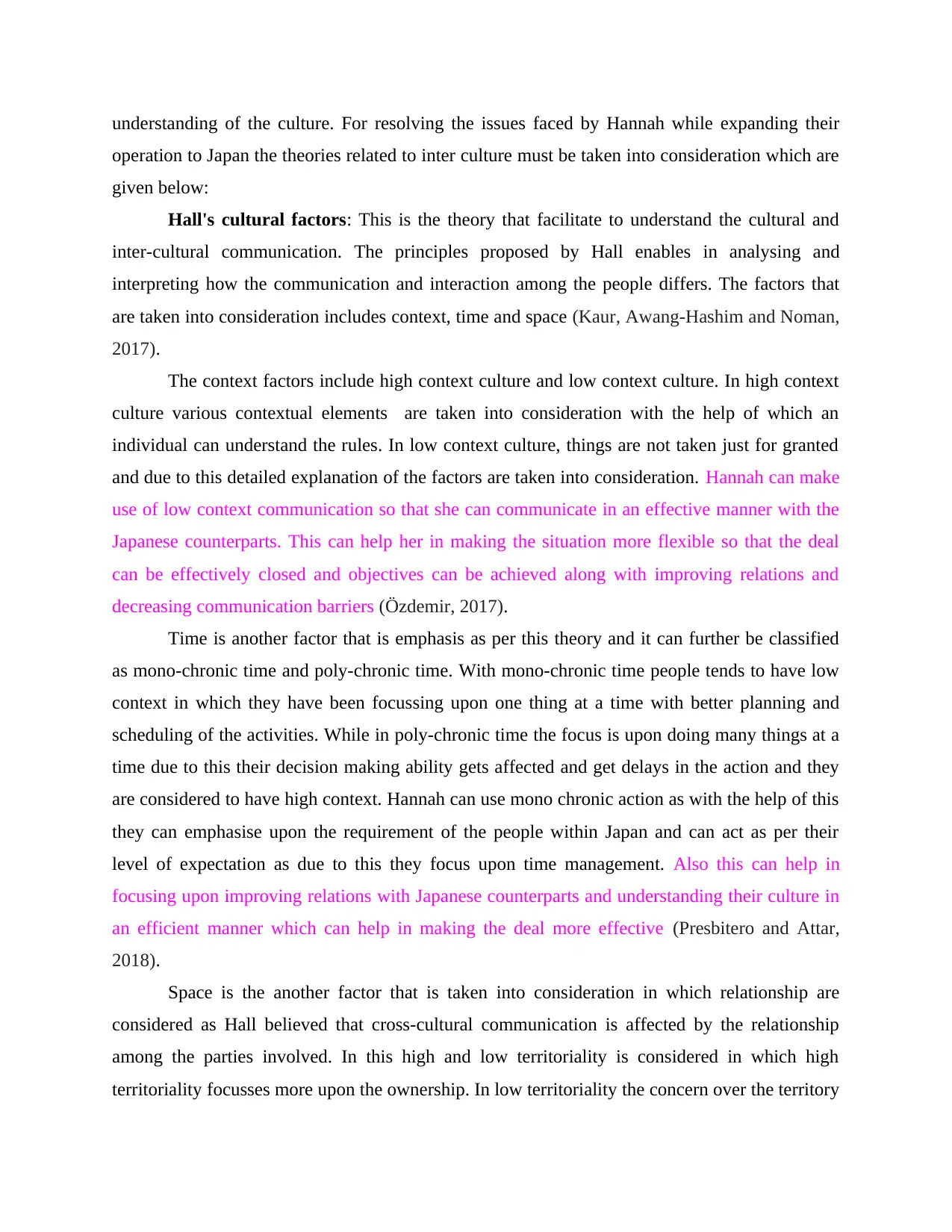
understanding of the culture. For resolving the issues faced by Hannah while expanding their
operation to Japan the theories related to inter culture must be taken into consideration which are
given below:
Hall's cultural factors: This is the theory that facilitate to understand the cultural and
inter-cultural communication. The principles proposed by Hall enables in analysing and
interpreting how the communication and interaction among the people differs. The factors that
are taken into consideration includes context, time and space (Kaur, Awang-Hashim and Noman,
2017).
The context factors include high context culture and low context culture. In high context
culture various contextual elements are taken into consideration with the help of which an
individual can understand the rules. In low context culture, things are not taken just for granted
and due to this detailed explanation of the factors are taken into consideration. Hannah can make
use of low context communication so that she can communicate in an effective manner with the
Japanese counterparts. This can help her in making the situation more flexible so that the deal
can be effectively closed and objectives can be achieved along with improving relations and
decreasing communication barriers (Özdemir, 2017).
Time is another factor that is emphasis as per this theory and it can further be classified
as mono-chronic time and poly-chronic time. With mono-chronic time people tends to have low
context in which they have been focussing upon one thing at a time with better planning and
scheduling of the activities. While in poly-chronic time the focus is upon doing many things at a
time due to this their decision making ability gets affected and get delays in the action and they
are considered to have high context. Hannah can use mono chronic action as with the help of this
they can emphasise upon the requirement of the people within Japan and can act as per their
level of expectation as due to this they focus upon time management. Also this can help in
focusing upon improving relations with Japanese counterparts and understanding their culture in
an efficient manner which can help in making the deal more effective (Presbitero and Attar,
2018).
Space is the another factor that is taken into consideration in which relationship are
considered as Hall believed that cross-cultural communication is affected by the relationship
among the parties involved. In this high and low territoriality is considered in which high
territoriality focusses more upon the ownership. In low territoriality the concern over the territory
operation to Japan the theories related to inter culture must be taken into consideration which are
given below:
Hall's cultural factors: This is the theory that facilitate to understand the cultural and
inter-cultural communication. The principles proposed by Hall enables in analysing and
interpreting how the communication and interaction among the people differs. The factors that
are taken into consideration includes context, time and space (Kaur, Awang-Hashim and Noman,
2017).
The context factors include high context culture and low context culture. In high context
culture various contextual elements are taken into consideration with the help of which an
individual can understand the rules. In low context culture, things are not taken just for granted
and due to this detailed explanation of the factors are taken into consideration. Hannah can make
use of low context communication so that she can communicate in an effective manner with the
Japanese counterparts. This can help her in making the situation more flexible so that the deal
can be effectively closed and objectives can be achieved along with improving relations and
decreasing communication barriers (Özdemir, 2017).
Time is another factor that is emphasis as per this theory and it can further be classified
as mono-chronic time and poly-chronic time. With mono-chronic time people tends to have low
context in which they have been focussing upon one thing at a time with better planning and
scheduling of the activities. While in poly-chronic time the focus is upon doing many things at a
time due to this their decision making ability gets affected and get delays in the action and they
are considered to have high context. Hannah can use mono chronic action as with the help of this
they can emphasise upon the requirement of the people within Japan and can act as per their
level of expectation as due to this they focus upon time management. Also this can help in
focusing upon improving relations with Japanese counterparts and understanding their culture in
an efficient manner which can help in making the deal more effective (Presbitero and Attar,
2018).
Space is the another factor that is taken into consideration in which relationship are
considered as Hall believed that cross-cultural communication is affected by the relationship
among the parties involved. In this high and low territoriality is considered in which high
territoriality focusses more upon the ownership. In low territoriality the concern over the territory
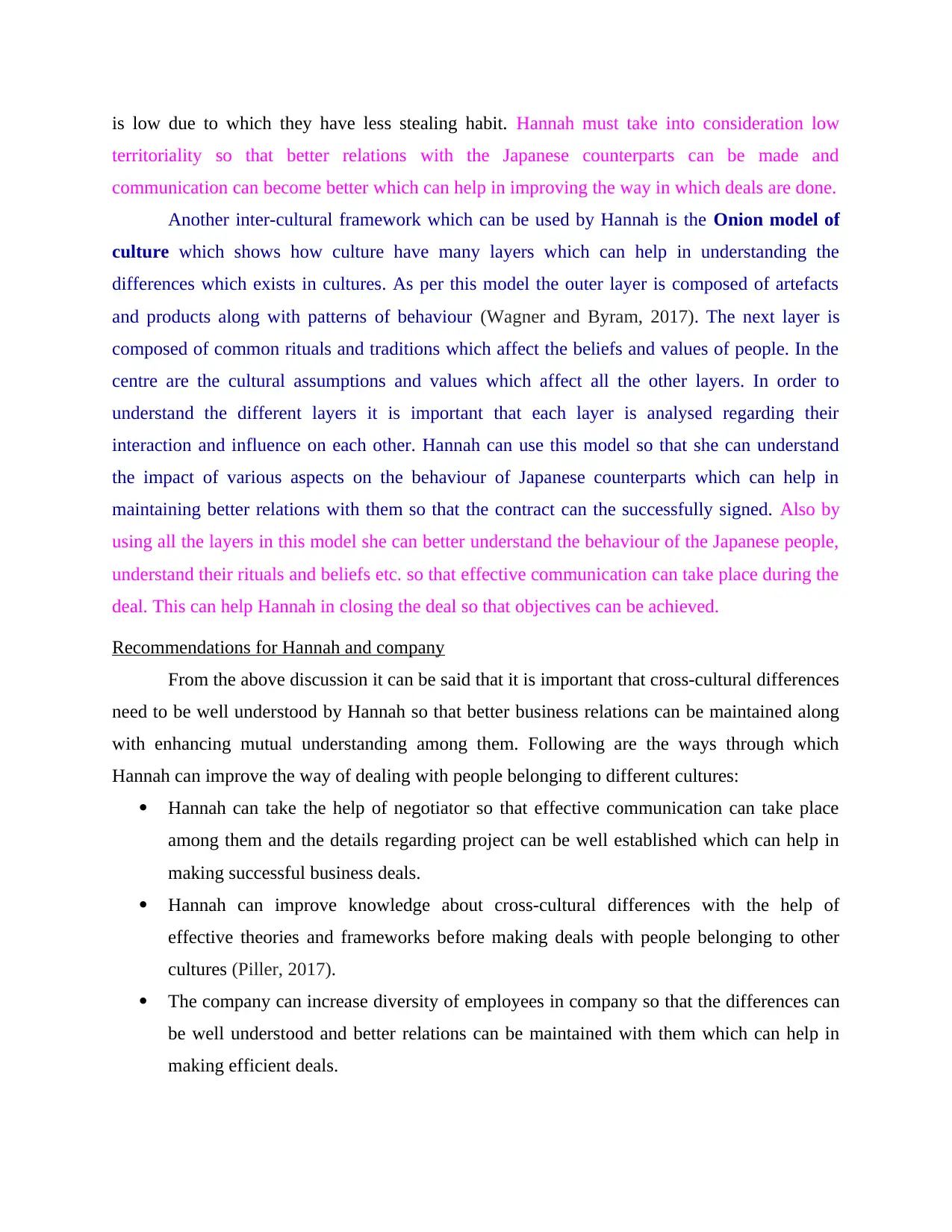
is low due to which they have less stealing habit. Hannah must take into consideration low
territoriality so that better relations with the Japanese counterparts can be made and
communication can become better which can help in improving the way in which deals are done.
Another inter-cultural framework which can be used by Hannah is the Onion model of
culture which shows how culture have many layers which can help in understanding the
differences which exists in cultures. As per this model the outer layer is composed of artefacts
and products along with patterns of behaviour (Wagner and Byram, 2017). The next layer is
composed of common rituals and traditions which affect the beliefs and values of people. In the
centre are the cultural assumptions and values which affect all the other layers. In order to
understand the different layers it is important that each layer is analysed regarding their
interaction and influence on each other. Hannah can use this model so that she can understand
the impact of various aspects on the behaviour of Japanese counterparts which can help in
maintaining better relations with them so that the contract can the successfully signed. Also by
using all the layers in this model she can better understand the behaviour of the Japanese people,
understand their rituals and beliefs etc. so that effective communication can take place during the
deal. This can help Hannah in closing the deal so that objectives can be achieved.
Recommendations for Hannah and company
From the above discussion it can be said that it is important that cross-cultural differences
need to be well understood by Hannah so that better business relations can be maintained along
with enhancing mutual understanding among them. Following are the ways through which
Hannah can improve the way of dealing with people belonging to different cultures:
Hannah can take the help of negotiator so that effective communication can take place
among them and the details regarding project can be well established which can help in
making successful business deals.
Hannah can improve knowledge about cross-cultural differences with the help of
effective theories and frameworks before making deals with people belonging to other
cultures (Piller, 2017).
The company can increase diversity of employees in company so that the differences can
be well understood and better relations can be maintained with them which can help in
making efficient deals.
territoriality so that better relations with the Japanese counterparts can be made and
communication can become better which can help in improving the way in which deals are done.
Another inter-cultural framework which can be used by Hannah is the Onion model of
culture which shows how culture have many layers which can help in understanding the
differences which exists in cultures. As per this model the outer layer is composed of artefacts
and products along with patterns of behaviour (Wagner and Byram, 2017). The next layer is
composed of common rituals and traditions which affect the beliefs and values of people. In the
centre are the cultural assumptions and values which affect all the other layers. In order to
understand the different layers it is important that each layer is analysed regarding their
interaction and influence on each other. Hannah can use this model so that she can understand
the impact of various aspects on the behaviour of Japanese counterparts which can help in
maintaining better relations with them so that the contract can the successfully signed. Also by
using all the layers in this model she can better understand the behaviour of the Japanese people,
understand their rituals and beliefs etc. so that effective communication can take place during the
deal. This can help Hannah in closing the deal so that objectives can be achieved.
Recommendations for Hannah and company
From the above discussion it can be said that it is important that cross-cultural differences
need to be well understood by Hannah so that better business relations can be maintained along
with enhancing mutual understanding among them. Following are the ways through which
Hannah can improve the way of dealing with people belonging to different cultures:
Hannah can take the help of negotiator so that effective communication can take place
among them and the details regarding project can be well established which can help in
making successful business deals.
Hannah can improve knowledge about cross-cultural differences with the help of
effective theories and frameworks before making deals with people belonging to other
cultures (Piller, 2017).
The company can increase diversity of employees in company so that the differences can
be well understood and better relations can be maintained with them which can help in
making efficient deals.
⊘ This is a preview!⊘
Do you want full access?
Subscribe today to unlock all pages.

Trusted by 1+ million students worldwide
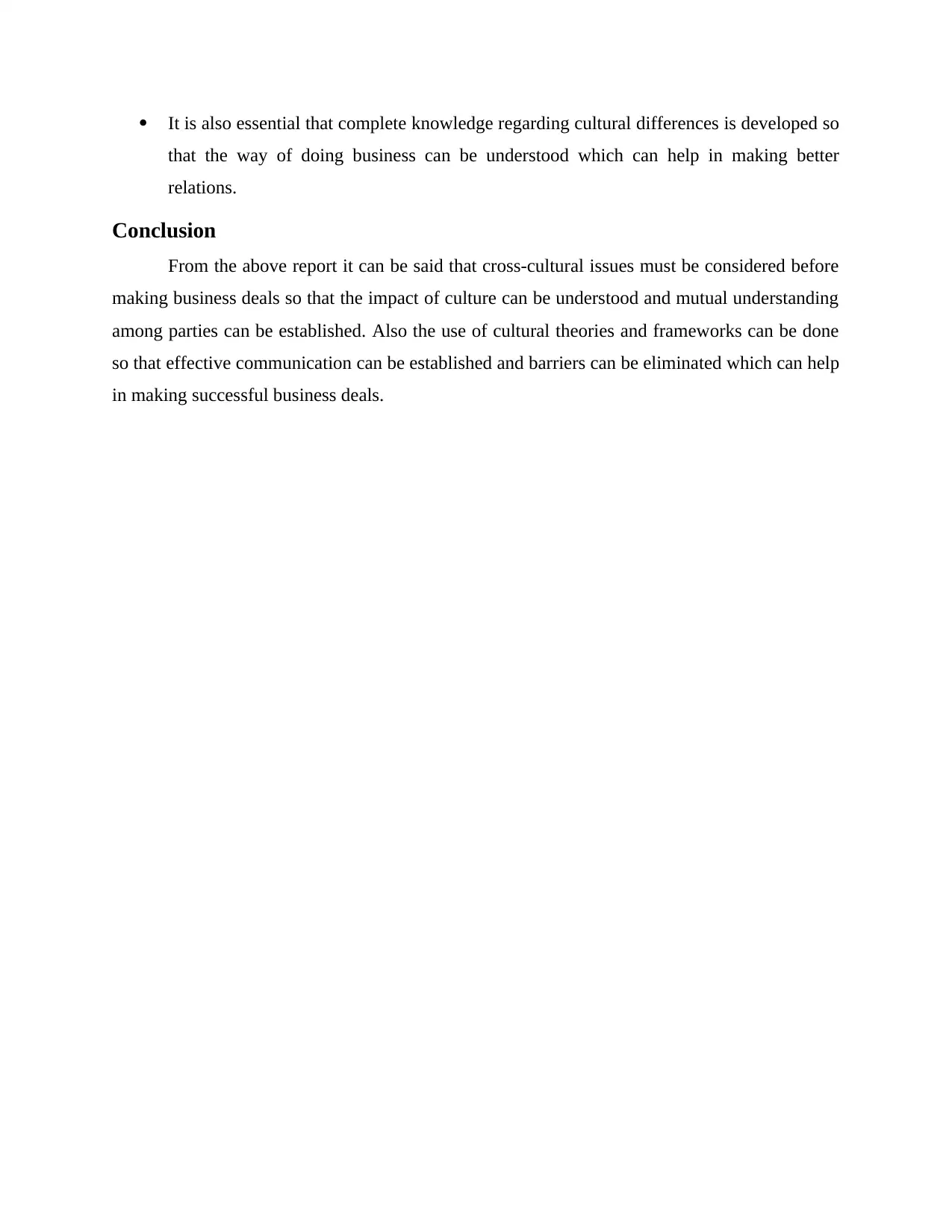
It is also essential that complete knowledge regarding cultural differences is developed so
that the way of doing business can be understood which can help in making better
relations.
Conclusion
From the above report it can be said that cross-cultural issues must be considered before
making business deals so that the impact of culture can be understood and mutual understanding
among parties can be established. Also the use of cultural theories and frameworks can be done
so that effective communication can be established and barriers can be eliminated which can help
in making successful business deals.
that the way of doing business can be understood which can help in making better
relations.
Conclusion
From the above report it can be said that cross-cultural issues must be considered before
making business deals so that the impact of culture can be understood and mutual understanding
among parties can be established. Also the use of cultural theories and frameworks can be done
so that effective communication can be established and barriers can be eliminated which can help
in making successful business deals.
Paraphrase This Document
Need a fresh take? Get an instant paraphrase of this document with our AI Paraphraser
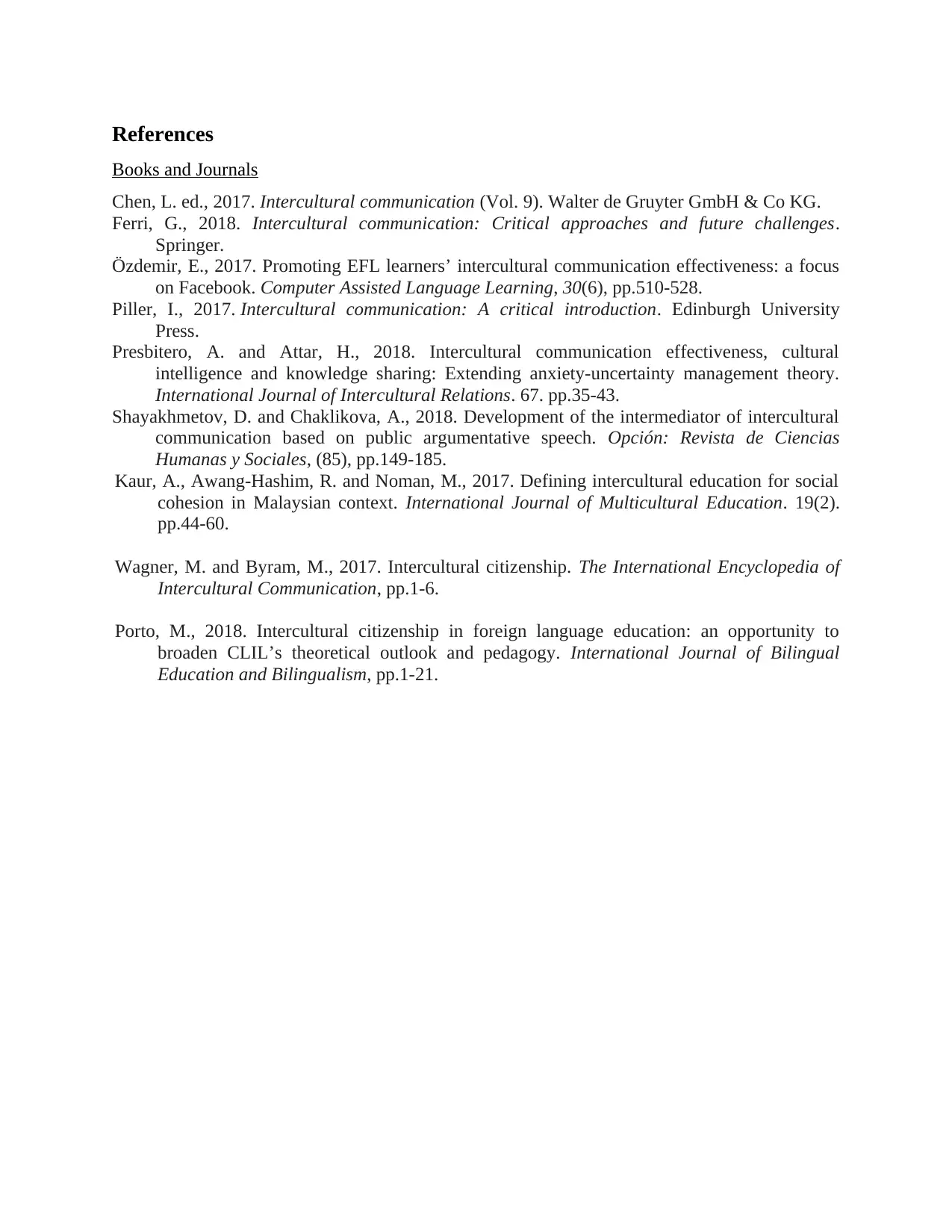
References
Books and Journals
Chen, L. ed., 2017. Intercultural communication (Vol. 9). Walter de Gruyter GmbH & Co KG.
Ferri, G., 2018. Intercultural communication: Critical approaches and future challenges.
Springer.
Özdemir, E., 2017. Promoting EFL learners’ intercultural communication effectiveness: a focus
on Facebook. Computer Assisted Language Learning, 30(6), pp.510-528.
Piller, I., 2017. Intercultural communication: A critical introduction. Edinburgh University
Press.
Presbitero, A. and Attar, H., 2018. Intercultural communication effectiveness, cultural
intelligence and knowledge sharing: Extending anxiety-uncertainty management theory.
International Journal of Intercultural Relations. 67. pp.35-43.
Shayakhmetov, D. and Chaklikova, A., 2018. Development of the intermediator of intercultural
communication based on public argumentative speech. Opción: Revista de Ciencias
Humanas y Sociales, (85), pp.149-185.
Kaur, A., Awang-Hashim, R. and Noman, M., 2017. Defining intercultural education for social
cohesion in Malaysian context. International Journal of Multicultural Education. 19(2).
pp.44-60.
Wagner, M. and Byram, M., 2017. Intercultural citizenship. The International Encyclopedia of
Intercultural Communication, pp.1-6.
Porto, M., 2018. Intercultural citizenship in foreign language education: an opportunity to
broaden CLIL’s theoretical outlook and pedagogy. International Journal of Bilingual
Education and Bilingualism, pp.1-21.
Books and Journals
Chen, L. ed., 2017. Intercultural communication (Vol. 9). Walter de Gruyter GmbH & Co KG.
Ferri, G., 2018. Intercultural communication: Critical approaches and future challenges.
Springer.
Özdemir, E., 2017. Promoting EFL learners’ intercultural communication effectiveness: a focus
on Facebook. Computer Assisted Language Learning, 30(6), pp.510-528.
Piller, I., 2017. Intercultural communication: A critical introduction. Edinburgh University
Press.
Presbitero, A. and Attar, H., 2018. Intercultural communication effectiveness, cultural
intelligence and knowledge sharing: Extending anxiety-uncertainty management theory.
International Journal of Intercultural Relations. 67. pp.35-43.
Shayakhmetov, D. and Chaklikova, A., 2018. Development of the intermediator of intercultural
communication based on public argumentative speech. Opción: Revista de Ciencias
Humanas y Sociales, (85), pp.149-185.
Kaur, A., Awang-Hashim, R. and Noman, M., 2017. Defining intercultural education for social
cohesion in Malaysian context. International Journal of Multicultural Education. 19(2).
pp.44-60.
Wagner, M. and Byram, M., 2017. Intercultural citizenship. The International Encyclopedia of
Intercultural Communication, pp.1-6.
Porto, M., 2018. Intercultural citizenship in foreign language education: an opportunity to
broaden CLIL’s theoretical outlook and pedagogy. International Journal of Bilingual
Education and Bilingualism, pp.1-21.

⊘ This is a preview!⊘
Do you want full access?
Subscribe today to unlock all pages.

Trusted by 1+ million students worldwide
1 out of 9
Related Documents
Your All-in-One AI-Powered Toolkit for Academic Success.
+13062052269
info@desklib.com
Available 24*7 on WhatsApp / Email
![[object Object]](/_next/static/media/star-bottom.7253800d.svg)
Unlock your academic potential
Copyright © 2020–2025 A2Z Services. All Rights Reserved. Developed and managed by ZUCOL.





